Characteristics of the Paleozoic slope break system and its control on stratigraphic-lithologic traps: An example from the Tarim Basin, western China
Ho Liu *, Chng-Song Lin Rui-Bo Guo, Min Zhu, Yong-Qin Cui
a School of Ocean Sciences, China University of Geosciences (Beijing), Beijing 100083, China
b Institute of Pet Engineering, Heriot-Watt University, Edinburgh, EH14 4AS, United Kingdom
c Geophysical Exploration Research Institute of PetroChina Huabei Oilfield Company, Renqiu 062552, China
KEYWORDS Early Paleozoic;structural unconformity;slope break system;stratigraphic-lithologic trap;Tarim Basin
Abstract Based on comprehensive analyses of seismic and log data, this study indicates that mainly four widespread angular to minor angular unconformities (Tg8, Tg51, Tg5 and Tg3)were formed during the Paleozoic. Through the interpretation of structural unconformities,calculation of eroded thickness, correction of palaeo-water depth and compaction and compilation of the Early Paleozoic structural maps, the Early Paleozoic slope break belt (geomorphologic unit) of the Tarim Basin is subdivided into uplift area, subaqueous uplift area, rift slope break belt, flexure slope break belt (slope belt), depression area and deep basin area. Palaeogeomorphology of the Cambrian-Early Ordovician was approximately in EW trend within which three tectonic units including the Tabei Palaeo-uplift, the northern Depressional Belt and the southern Palaeo-uplift developed respectively and are grouped into two slope break systems namely as the Tabei Palaeo-uplift and the southern Palaeo-uplift. These tectonic units obviously control the deposition of isolated platform, open platform, restricted platform and deep basin. Influenced by extrusion in the Mid-Late Ordovician, the southern and northern subaqueous uplifts gradually elevated and then were eroded. Resultantly two slope break systems developed, namely as the northern and central Palaeo-uplifts which obviously controlled the deposition of provenance area, isolated platform, mixed continental shelf, slope and basin facies. The intensive extrusion of the Mid-Late Ordovician leads to significant tectonic deformation of the Tarim Basin: large area of uplifting and erosion and development of EW trending anticline and syncline. Deposition of shore, tidal flat, delta, shallow marine clastics and deep marine facies is obviously controlled by the Tabei, the southern and the Tadong Palaeo-uplifts. Slope break systems control development of stratigraphic unconformity and thus truncation and onlap unconformity zones become favorable areas in a palaeo-uplift and at a palaeo-slope belt for forming important unconformity traps; Whereas slope (slope break)belt along a palaeo-uplift margin is a geomorphologic unit where high-energy sedimentary facies widely develops, such as reef, oolitic sandy clastics or bioclastic limestone beach bar facies, thus litho-structural composite hydrocarbon accumulations usually develop when tectonic condition is suitable. In addition, large-scale palaeo-uplifts are the most favourable areas for hydrocarbon accumulation development.
1 Introduction
In recent years, fundamental principles of sequence stratigraphy have been applied to analyses of basin fills formed in various tectonic settings (e.g., Obrist-Farner and Yang, 2015; Posamentier et al., 1988; Posamentier and Morris, 2000; Posamentier and Vail, 1988; Vail et al., 1977; Van Wagoner et al., 1990). Particularly in hydrocarbon industry,the conceptual models have been widely used to predict hydrocarbon and reservoir distribution and geometries in basins (Catuneanu et al., 2009; Fyhn et al., 2009; Li et al.,2002; Lin et al., 2000; Lin et al., 2001; Paton et al., 2008;Prather, 2003; Wang et al., 2002; Zagrarni et al., 2008).Currently, many researchers proposed the concept of basin slope break belt through studies of sequence stratigraphy(Fan and Li, 1999; Huang et al., 2012; Lin et al., 2000;Liu et al., 2006; Ren et al., 2004; Wang et al., 2004; Xu et al., 2006) and divided it into tectonic slope break belt,erosional slope break belt and depositional slope break belt according to their origins. They also proposed that slope break belt controls the developing pattern of sequence,deposition and traps, which in turn control the development of reservoir sandbodies and subtle traps. But most preresearches are regarding a single or some kind of slope break belt or multi-order slope break belt, few of them are related with slope break association with a similar origin.Different kinds of slope break association (named as slope break systems) in basins are closely related with deep basal(basement) tectonic framework of a basin and its regional tectonic dynamic setting ( Liu et al., 2015). On a basin scale, these slope break belts actually reflect the characteristics of a prototype basin formed in a certain period.Slope break belts in the same slope break system obviously have original paragenetic relationships. Slope break system reflects the palaeogeomorphology in the same tectonic dynamic setting.
The Tarim Basin, located in western China, is a largescale superimposed basin bearing abundant energy resources. Three sets of hydrocarbon source rocks developed in the Tarim Basin, respectively as the Cambrian, the Middle-Upper Ordovician and the Carboniferous-Permian(Cai, 2007; Jin and Wang, 2004; Zhang et al., 2002, 2007;Zhao et al., 1999, 2007). From Precambrian to Quaternary, the Tarim Basin underwent tectonic changes over long and multiple periods. Oil and gas from the Paleozoic is mainly controlled by unconformities, palaeo-uplift and slope in the basin (He and Xie, 1997; Jia, 2005; Wang and Zhao, 2006; Zhai and He, 2004; Zhang et al., 2002; Zhao et al., 2002; Zhao et al., 2007). A number of studies have focused on the identification of the Paleozoic unconformities (e.g., Jin et al., 2009; Lin et al., 2008, 2012a, 2012b;Yang, 2005; Zhang et al., 2007), the origin of palaeo-uplift and its implication for hydrocarbon accumulation (e.g.,He et al., 2008; Jia and Wei, 1996; Jin et al., 2009; Lin et al., 2012a; Liu et al., 2012b; Liu and Wang, 2005; Pang et al., 2008; Xu, 2004; Zhai and He, 2004; Zhao et al., 2007;Zhao and Wu, 2001). More studies are still necessary regarding the following aspects: (1) Palaeogeograpphy, identification and subdivision of slope break belts of the Paleozoic in the basin have been analyzed mostly according to the present day remnant thickness and tectonic features,whereas palaeotectonic-palaeogeographic informations are lacking; (2) Preresearches are mostly with respect to a single or an isolated palaeo-uplift or a single slope break belt, while few of them are related to comprehensive analayses of slope break systems wihthin palaeotectonic units which are targeted at a specific palaeo-uplift.
This paper thus aims at: (1) identifying main unconformities of the Paleozoic through comprehensive analysis of seismic and borehole data within a basin wide; (2)reconstructing eroded thickness of main unconformities of the Paleozoic within the basin range via seismic extropolation interpretation technology, and compiling palaeogeomorphologic maps of post- and pre-key tectonic changing periods combined with correction of eroded thickness and palaeo-water depth; (3) subdividing different structural palaeogeomorphologic units based on structural sequences and analyzing slope break system characteristics of each second-order palaeo structural tectonic belt centered at a certain palaeo-uplift; (4) analyzing relationships between slope break system and unconformity distribution pattern and depositional systems, and furthermore discussing stratal control on lithologic traps.
2 Geological setting
With an area of 5.6×105km2, the Tarim Basin, the largest inland basin in China, is generally acknowledged as one of the most important areas for potential oil and gas exploration. Possessing the Pre-Precambrian craton crystalline basement, the Precambrian-Quaternary developed well with the thickest layer reaching up to16 000 m. The Tarim Basin is divided into several tectonic units including the Kuqa Depression, the North Uplift, the North Depression,the Central Uplift and the Southwest Depression (Fig. 1).
The Tarim Basin is located between the Pal-Asian and Paleo-Tethyan tectonic domains. It previously belonged to the Pal-Asian tectonic domain and was located on the northern margin of Gondwanaland. During the Meso-Cenozoic era, it was located in the northern Tethyan tectonic domain and was controlled by two dynamic systems - the Tethys and the Indian Ocean (Ren et al., 1999). The Tarim Basin experienced a multi-cycle tectonic evolution due to its structural setting. Six key tectonic changing periods respectively corresponded to the following unconformities: the Precambrian/Cambrian, Ordovician/Silurian, Silurian/Devonian, Permian/Triassic, Triassic/Jurassic, and Cretaceous/Paleogene (Jin et al., 2004; Lin et al., 2008;Yang, 2007; Zhang et al., 2007) (Fig. 2). Different types of basins were developed at different tectonic stages, but generally, the Meso-Cenozoic foreland-intracontinental depressional basin was superimposed on the Precambrian-Paleozoic marine cratonic basin. The Himalayan orogeny formed its most recent tectonic-geomorphic characteristics. The relatively smaller size of the Tarim cratonic plate, combined with frequent and active tectonic movements, led to instability of the Tarim Plate. Hence, a series of important tectonic changes occurred among the basins during different periods; these changes were superimposed one another. The prototype basin was superimposed and reconstructed by tectonic movements in later periods which changed its appearance and texture (He et al., 1998; Xu, 2002; Zhang, 1990; Zhang et al., 2007;Zhang and Song, 1998).
3 Data and methods
The present study utilizes data from 80 boreholes and 2-D and 3-D seismic profiles. Seismic data include 22 regional 2-D profiles across the entire Tarim Basin and 3-D data of the central and northern Tarim Palaeo-uplifts, which were processed by the China National Petroleum Corporation.
The first- and second-order boundary subdivision standards in seismic stratigraphy (Vail et al., 1977; Vail, 1987)were used as a reference to identify unconformities. Synthetic seismograms were used in the calibration of borehole-seismic data. Simultaneous interpretation of the main unconformities and virtual surfaces in eroded areas was mostly based on seismic data.
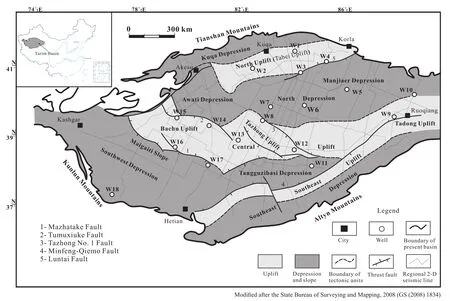
Figure 1 Schematic tectonic map of the Tarim Basin, showing the distribution of tectonic units within the basin and location of the boreholes (modified after Liu et al. 2012, 2015 online).
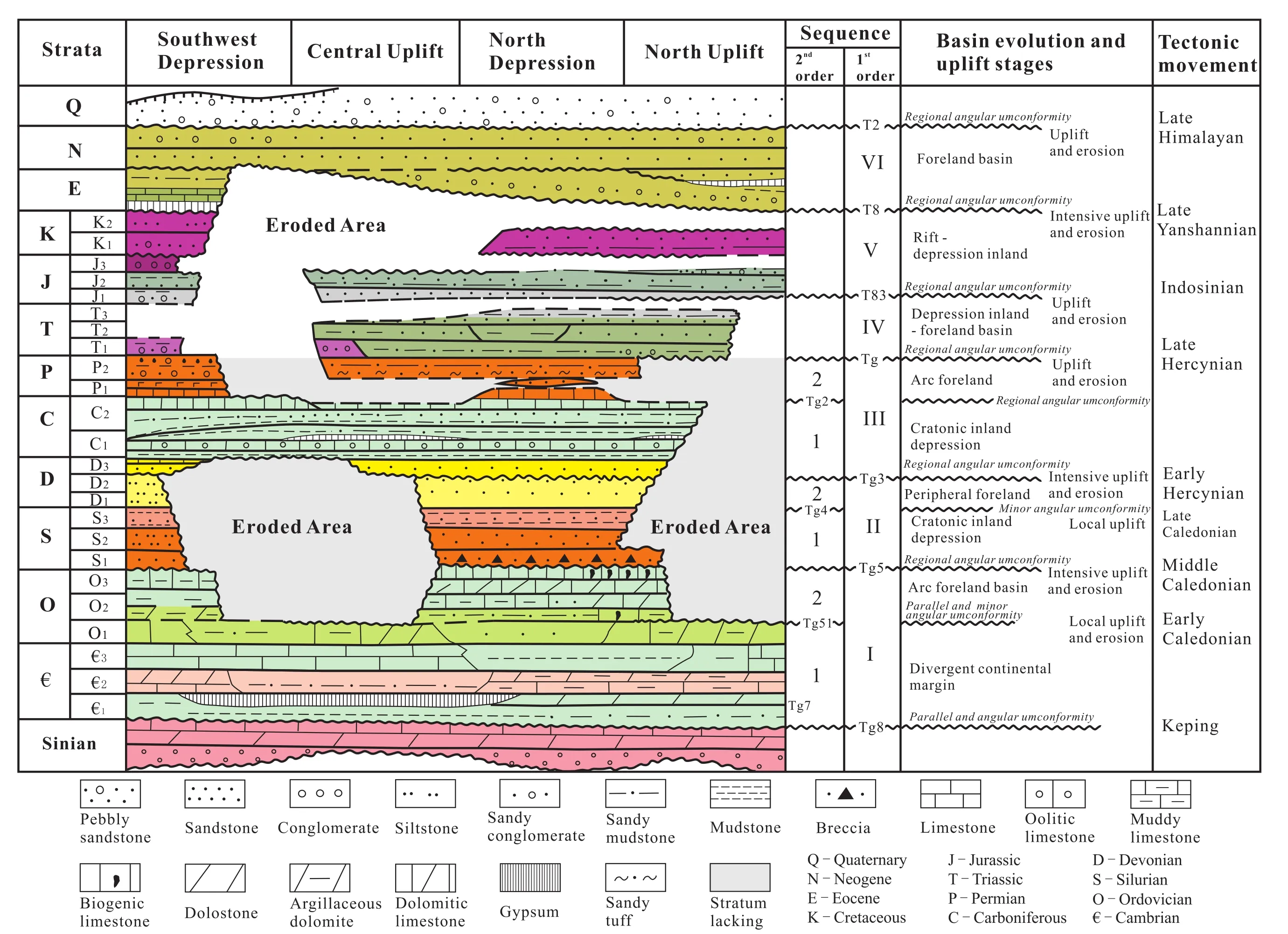
Figure2 Generalizedtectonostratigraphy of theTarim Basin, showing theunconformity-boundedsequences anddepositional evolutionand basindynamic setting. Note that sevenmajor angular unconformities (Tg8, Tg5, Tg3, Tg, T83, T8 andT2) formed during thebasin deformationstages( from Liuet al., 2015 online).
One of the challenges in tectonic reconstruction under eroded conditions in the Tarim Basin is the fact that marker bed and its underlying eroded strata cannot be located because many primary stratigraphic surfaces have been eroded, resulting in back-stripping to the underlying strata when back-stripping is conducted on the unconformities. A number of different techniques have been therefore used in recon-struction of the eroded thickness of the main unconformities in the Tarim Basin, including trace decimation display,horizon flattening, correction of space closure difference,gridding of planar interpolation and automatic mapping with seismic interpretation software (Geoframe). These techniques are different from stratal thickness tendency method, lying in that the texture of strata and sedimentology of uneroded strata (strata and deposition information) are taken into consideration in interpretation of virtual seismic surfaces (Liu et al., 2012, 2015 online)(Fig. 3).
The final compilation of geomorphologic maps of different periods were conducted as follows: first, the eroded thickness restoration of key tectonic change periods and the total eroded thickness restoration were carried out for each stage and each interval; and second, the eroded thickness was compensated to current remnant thickness combined with a correction of compaction and palaeowater depth. Correction of compaction focused on compaction curves of sandstone and mudstone, and porosity data were obtained from key areas (Tazhong Uplift, Tabei Uplift and southwestern Tarim Palaeo-uplift). Correction of palaeo-water depth is based on the research results of regional sedimentary facies (Liu et al., 2012b).
4 Main structural unconformites of the Paleozoic of the Tarim Basin
The Tarim Basin developed a series of significant unconformities during the Paleozoic (Fig. 4). These unconformities can be traced throughout most of the basin, and comprise boundaries of super-sequences or structural sequences. Their spatial and temporal distribution reflects fundamental stratigraphic characteristics of the basin.Based on analysis of seismic and log data, this study shows that four major widespread angular to micro angular unconformities (Tg8, Tg51, Tg5 and Tg3) were formed during the Paleozoic. Three tectonic sequence boundaries corresponded to the main tectonic change periods of the Paleozoic in the Tarim Basin, namely the Precambrian/Cambrian(Tg8),Ordovician/Silurian(Tg5), Middle/Late Devonian(Tg3). The relatively high-angle surface, deformed or hinged underlying strata, and associated thrust faults or fold structures all suggested that their origin was mainly related to tectonic events or compressive uplifting (Jin and Wang, 2004; Yang,2005; Zhang et al., 2007).
4.1 Unconformity Tg8
This unconformity, corresponding to the Keping movement period, influenced a large area, with a large range of erosion degree and strata thicknesses (He et al., 2006;Liu et al., 2012a). Therefore, most areas in the eastern part of the Central Uplift were completely eroded with remnant strata distributing in an isolated pattern (Fig. 5),such as the Well Tadong 1. The Well Tacan 1 was drilled into the Pre-Precambrian granitic gneiss. The high-angle unconformity in the eastern Yingjisu area and the variation of stratal thickness between the Cambrian and the Precambrian periods indicate that fold-back occurred in the Late Precambrian, followed by an open-closure cycle beginning in the Cambrian.

Figure 3 Illustration of reconstruction of the eroded thickness of major tectonic periods. Eroded thickness restoration in A shows development of stratal thickness, seismic reflection characteristics in areas where strata completely developed, and characteristics of sedimentary facies of the reconstructed strata; B is virtual seismic extrapolation from areas where strata completely developed to the first eroded point; C represents the distribution of total eroded thickness of unconformities of the Late Ordovician (Tg5) (modified from Liu et al., 2015 online).
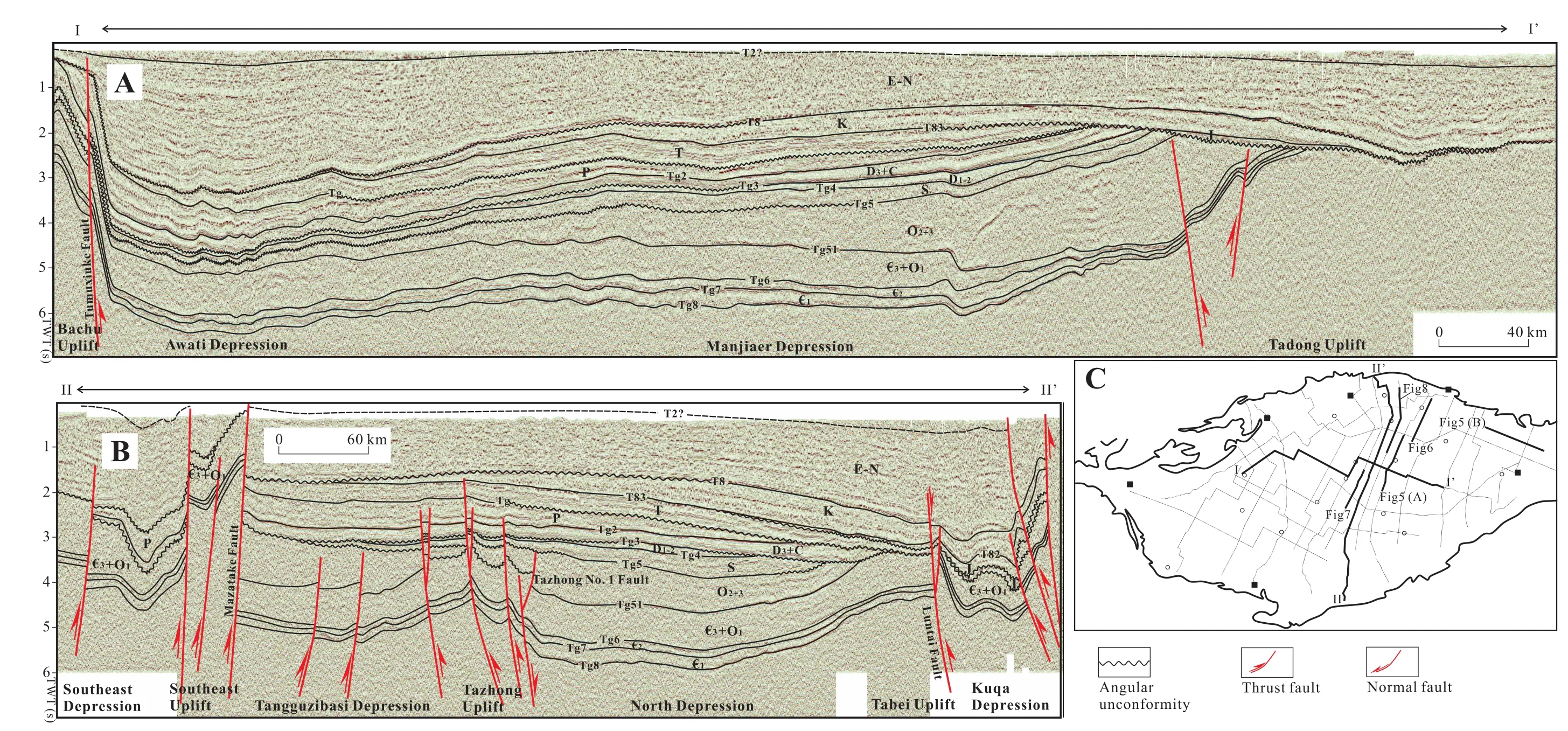
Figure4 E-W(A) andS-N (B) seismic interpretation profiles across thecentral TarimBasin; andC-Schematic mapindicatinglocations of 2-Dseismic profiles (solid blacklines) andboreholes (hollowblack circles) used in this study. Meaning of strata abbreviations areshown in Figure 2.
4.2 Unconformity Tg51
In the Late Ordovician, ocean basins and rift aulacogens along the southern margin of the Tarim Basin tended to amass and close (Charvet et al., 2011; Jia et al., 2004;Lin et al., 2012a; Yu et al., 2011) while the southern side of the Tarim Craton evoluted from an extensional environment into an extrusion setting. The Tabei and Tazhong Palaeo-uplifts developed their initial patterns and framed a palaeotopography of “high in southern and northern areas and low in central (the North Depression) part”. Along slope break belts between platform and the basin and in areas including the southern slopes of the Tazhong and Tabei Palaeo-uplifts, the Mid-Upper Ordovician overlapped and deposited towards uplift areas, and the Lower Ordovician in uplift areas was eroded which reflected an uplift feature of the Tabei and Tazhong areas at that period. In the basin,bounded by this unconformity (Tg51), the underlying strata are characterized by weak amplitude and chaotic reflection configuration on seismic profiles whereas the overlying strata are characterized by relatively continuous seismic reflection (Fig. 6).
4.3 Unconformity Tg5
It is a transitional period from the Early Caledonian cycle to the Late Caledonian cycle which corresponds approximately to the formation period of Tg5 unconformity. An obvious regional unconformity occurred between the Ordovician and Silurian which is much larger in scale than other unconformities in the Central Uplift of the Tarim Basin. The regional unconformity is widely distributed in the whole basin with quite large eroded thickness in the North Uplift and southern area of the Tarim Basin (Fig. 7). In the Early Caledonian cycle, the original basin changed from a cratonic margin aulacogen depression to a peripheral foreland basin which formed a typical Wilson cycle. In the Silurian-Devonian period, another complete basin tectonic cycle from a cratonic margin depression to a peripheral foreland basin was formed. Obviously the tectonic setting changed greatly during the period from Early Cambrian to Late Ordovician based on correlation of the structural maps of the Cambrian bottom boundary between the Early and Late Cambrian.
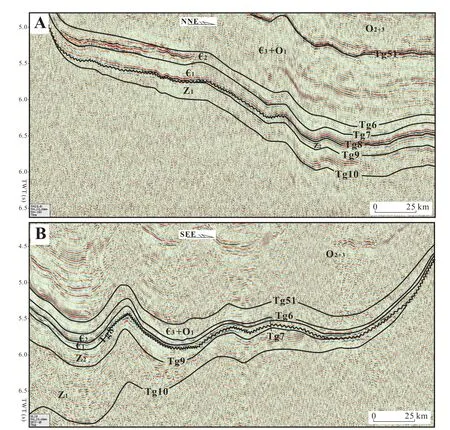
Figure 5 Seismic reflection characteristics of Tg8 showing its obvious truncation to the underlying Precambrian. Locations of seismic profiles are shown in Figure 4c.
4.4 Unconformity Tg3
It is a transitional period from the Late Caledonian cycle to the Hercynian cycle which corresponds approximately to the formation period of Tg3 unconformity. Tg3 is widely distributed and has been intensively eroded (Fig.8). Above and below the unconformity, the structural and sedimentary characteristics are quite different. At the Late Caledonian period, the main original basin changed from a Silurian cratonic margin depression to a Devonian peripheral foreland basin. Then, an evolutionary succession from a cratonic margin depression to a back-arc foreland basin was formed during the Hercynian cycle.
5 Slope break system of the Early Paleozoic and its relationship with depositional systems in the Tarim Basin
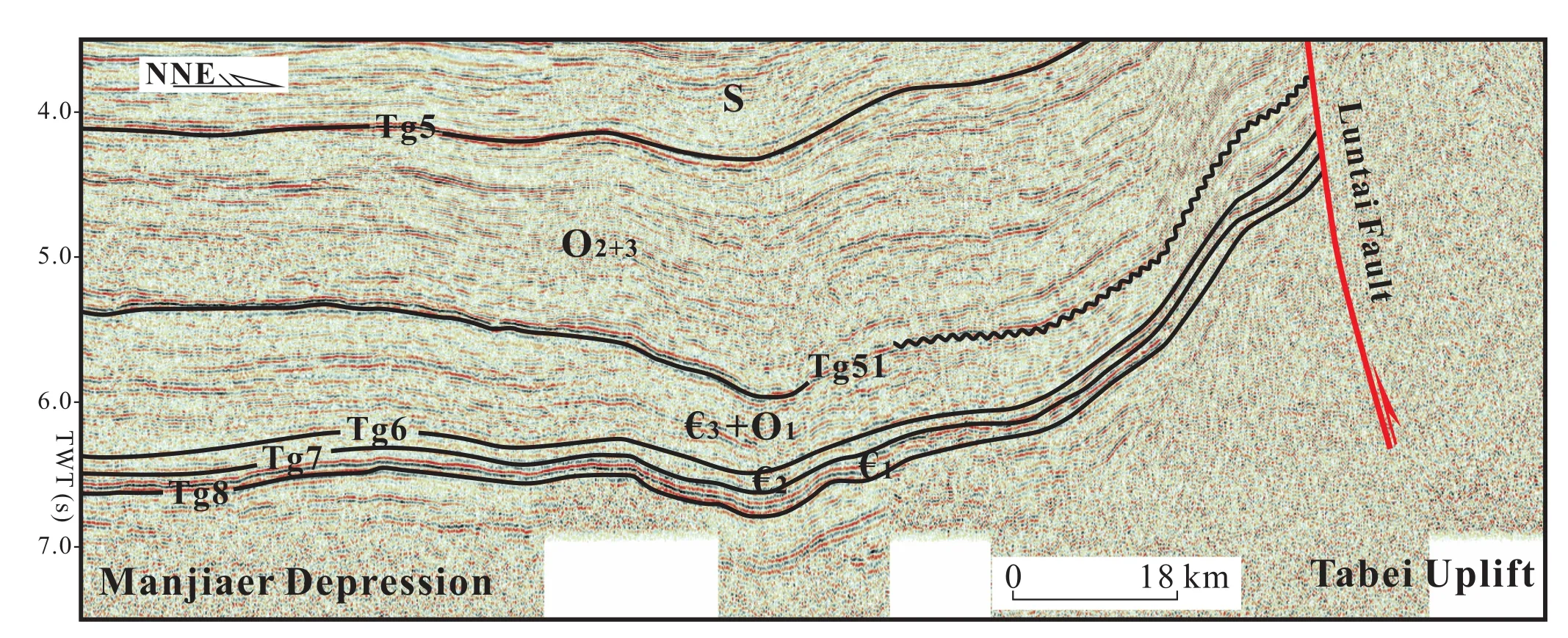
Figure 6 Seismic reflection characteristics of Tg51. Locations of seismic profiles are shown in Figure 4c.
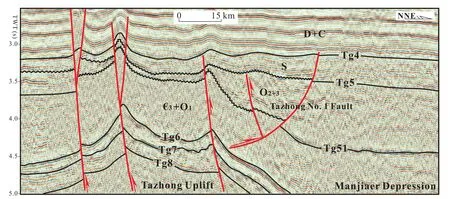
Figure 7 Seismic reflection characteristics of unconformity Tg5 in the Central Uplift. The seismic profile indicated that it was a typical onlap and truncation unconformity. Locations of seismic profiles are shown in Figure 4c.
Calculation of eroded thickness, compaction and palaeowater depth reconstruction are key aspects in reconstructing palaeogeomorphology. Among which, restoration of eroded thickness is critical. Followings need to be considered when calculating eroded thickness given the multiperiod superimposed characteristic of unconformities in the Tarim Basin: the total eroded quantity at a key tectonic changing period, individually eroded quantity of underlying strata during that structural period and eroded quantities of the same interval at different structural periods.Tectono-palaeogeomorphological maps of main structural sequences of the Early Paleozoic were compiled through restoration of the Early Paleozoic eroded thickness (Liu et al., 2012a) combined with correction of burial depth and palaeo-water depth (Liu et al., 2012b).
5.1 The Cambrian-Early Ordovician slope break system and its depositional response
The Cambrian-Early Ordovician of the Tarim Basin displayed an approximate EW trending palaeogeomorphologic framework which can be subdivided into the Tabei Palaeo-uplift, the northern Depressional Belt and the southern Palaeo-uplift (Fig. 9). Regional tectonics indicate a stable extension setting from Cambrian to Early Ordovician, and large-scale palaeo-uplift belts including the southern and Tabei Palaeo-uplifts along the southern and northern sides of the Tarim Basin are closely related to palaeo-ocean basins cleavage of the Tianshan and Kunlun Mountains.
The Cambrian-Early Ordovician slope break belt dominantly includes fault slope break belt, flexure (slope) break belt, continental shelf slope break belt, and its relevant palaeogeomorphologic units include depression area and deep basin area (Fig. 9). Continental shelf slope break belt is a dominant type of that period with slope break width of about 50 km, height difference at about 2 500 m, distributing mainly in the eastern Manjiaer Sag in a SN direction.Continental shelf slope break was not developed in the Early Cambrian, but took shape in the Middle Cambrian and developed with an increasing scale during the Late Cambrian-Early Ordovician. Palaeo-uplifts of the Cambrian-Early Ordovician were dominantly subaqueous low uplifts. Fault slope break belts were mainly the Luntai Fault developed along the southern side of the Tabei Palaeo-uplift and the Mazhatake and Tumuxiuke Faults on the southern Palaeouplift both indicating similar and obviously syndepositional characteristics.
Slope break system of this period was subdivided into the Tabei and southern Palaeo-uplift systems according to the Cambrian-Early Ordovician palaeogeomorphologic framework. The Tabei Palaeo-uplift system consisted of the Tabei subaqueous low uplift, Lunnan fault slope break belt, flexure (slope) break belt and continental shelf slope break belt. The flexure slope break belt, with a steep gradient, was located on the southern side of the Tabei low uplift. With a similar composition as the northern Palaeouplift, the southern Palaeo-uplift consists of subaqueous low uplift, fault slope break belt, slope belt and continental shelf break belt from SW to NE, showing an obvious multi-order slope break belt associations. Its slope belt covers a larger distribution area (Fig. 10) with an apparently gentler gradient compared with the northern slope break system. Subaqueous low uplifts among the southern and Tabei Palaeo-uplifts mainly controlled depostion of isolated platform, open carbonate platform deposited in areas from two sides of the uplift towards the basin, and fault slope break belt separated isolated platform from open platform facies (Fig. 9). Rift of the Manjiaer aulacogen was associated with development of the Tabei Palaeouplift. The Tazhong Palaeo-uplift, dominated by a weakly extentsional and passive continental slope margin environment, did not take shape during the Cambrian-Early Ordovician. The northwestern depression belt, i.e., the Awati Depression, controlled restricted carbonate platform deposition. Marginal reef facies probably developed along shelf slope break margin with lithology of calcareous clastics and calcareous turbidite deposits, gray micritic-sitly limestone, deep water black calcareous mudstone.The eastern area below the shelf slope break was deep ba-sin area where black gray muddy limestone and mudstone deposited. In addition, a series of small-scale syndepositional normal faults and grabens or half-grabens of the Precambrian-Late Cambrian developed along the southern Palaeo-uplift belt (including the present-day Tazhong structural belt). The apprant seismic characteristics (Fig.11) indicated a weakly extensional or passive continental margin environment in the Early Paleozoic, which, at the same time, controlled deposition of restricted platform carbonates, evaporative platform carbonates and gypsumbearing mudstone and salt rocks.
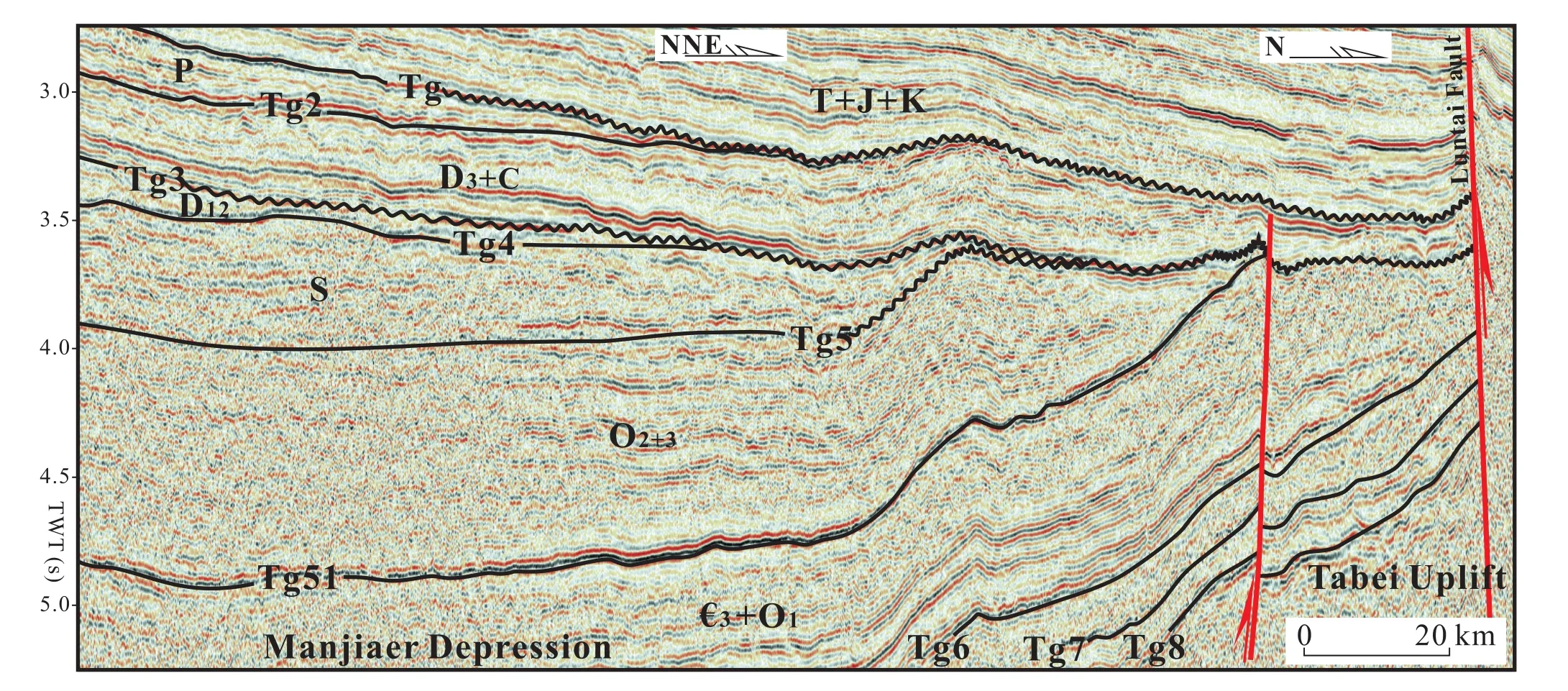
Figure 8 Characteristics of Tg3 unconformity adjacent to the North Uplift. Seismic profile obviously indicates characteristics of the unconformity, and truncation apparently occurred towards the underlying Ordovician-Devonian. Locations of seismic profiles are shown in Figure 4c.

Figure 9 Tectonic palaeogeomorphology and sedimentary facies of the Cambrian-Ordovician in the Tarim Basin. Note that subaqueous lower uplift, slope, local depression, continental shelf and deep basin developed during this period. Restricted platform developed in local depression areas. The subaqueous lower uplift and the continental shelf belt control the deposition of bioclastic limestone with high quality reservoir properties. A is a 3-D palaeostructural map of Cambrian-Early Ordovician (Figure 9B is modified from Liu et al.,2015 online).
5.2 Mid-Late Ordovician slope break system and its depositional response

Figure 10 Developing characteristics of the Cambrian-Early Ordovician slope break belt in areas from the southern Palaeo-uplift to the Manjiaer Depression. Seismic profile is shown after Tg5 being flattened for a better display of the palaeogeomorphologic characteristics of the Cambrian-Early Ordovician. For seismic profile location, seeing Figure 9.
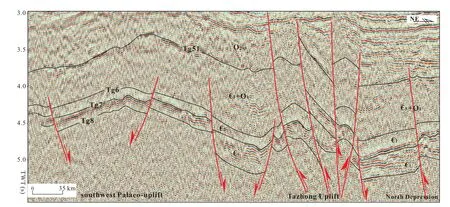
Figure 11 Distribution of small-scale syndepositional normal faults of the Cambrian-Early and Late Ordovician in the southern Tarim Basin. The locations of seismic profiles are shown in Figure 9.
The Tarim Basin entered into an extrusion setting since the Mid-Late Ordovician and reached the maximum extrusion in the Late Odovician after experiencing the formation period of aulacogen depression along the craton margin in the Cambrian-Early Ordovician. The basin evoluted into a“two uplifts and two depressions” framework within which the southern depressional belt, Central Uplift belt (including the Taxi’nan and Tazhong Palaeo-uplifts), the northern depressional belt and the northern uplift belt (Tabei Palaeouplift) (Fig. 12). Slope break belts or geomorphologic units dominantly consist of uplifting erosional area, low uplift area, fault slope break belt, flexure slope break belt (slope belt), shelf slope break belt, depressional area and deep basin area. Uplift area of this period was mainly palaeouplift formed by strata uplift in an extrusion setting with a smaller range compared with palaeouplift formed due to intensive extrusion in the Late Ordovician. Two syndepositional faults developed on southern and northern sides of the Tazhong Palaeo-uplift respectively besides three fault slope break belts inherited from the Cambrian-Early Ordovician, of which, the Tazhong No. 1 Fault was located on north side with larger scale. Shelf slope break belt, showing an inheritance characteristic, developed with relatively smaller scale and apparently reduced height compared to the early period which was more obvious on the northern side than the southern segment of the slope break belt.
Slope break system of this period was subdivided into the northern and central uplifts according to palaeostructural framework of the Mid-Late Ordovician. Within the northern uplift slope system, the Tabei Palaeo-uplift was an erosion area, and the Lunnan fault slope break belt, subaqueous uplift, slope belt and continental shelf slope break belt developed respectively towards southeast (Fig. 13). Slope systems along the northern and southern sides of the Central Uplift were different. Towards the south, palaeo-uplift erosion area, subaqueous uplift, slope belt and depression area developed respectively; and towards the northeast,slope break system extended far away and respectively developed palaeo-uplift erosion area, subaqueous uplift, fault slope break belt, slope belt and continental shelf slope break belt. Fault slope break belt with a multi-order developed at many locations, such as the Mazatake Fault slope break belt, neighbouring the erosion uplift area, separated the erosion area from the subaqueous uplift. The Tumuxiuke and Tazhong No. 1 faults were second-order fault slope break belts which separated subaqueous uplift and depression of the basin.
The Central Uplift and northern Palaeo-uplift slope break systems shared the same characterisitc: From palaeo-uplift erosion area towards depression area, palaeogeomorphologic assciations constituted by multi-order slope break belts or geomorphologic units apparently controlled deposition of provenance area, isolated platform, mixed continental shelf facies, slope facies and basin facies. For example, subsidence of the Mid-Late Ordovician Tanggubazisi Depression led to deposition of thick-bedded turbidites in a relatively deep environment; Controlled by palaeo-uplift,a peninsula-type carbonate platform system was formed.High energy sedimentary facies like bioreef and beach bar were widely developed along the platform margin and served as important hydrocarbon reservoir of the basin;Controlled by EN-oriented continental shelf slope break belt, basin floor fan turbidite clastics with great thickneses deposited in the Manjiaer Depression which were characterized by development of deep water turbidite system,deep water continental shelf and mixed shallow marinesemi-deep marine facies; Many syndepositional thrusting faults developed in the basin and exerted an apparent control on strata and deposition.
5.3 Slope break belt system of the Silurian-Early-Middle Devonian and its depositional response
Great tectonic deformation occurred in the Tarim Basin after intensive extrusion of the Mid-Late Ordovician. Tectonic deformation was characterized by large-area uplifting and erosion, development of anticline and syncline in EW direction and formation of the Tadong Palaeo-uplift as well.Tectonically it was subdivided into the Tabei Palaeo-uplift in an approximately EW direction, the northern Depression Belt, the southern Palaeo-uplift (including the Taxi’nan and Tazhong Palaeo-uplifts) and the Tadong Palaeo-uplift (Fig.14). The Silurian-Early-Middle Devonian was therefore,characterized by development of large-scale palaeo-uplift and erosion areas. These palaeo-uplifts usually distributed widely and were divided into higher and lower uplift areas according to shape and eroded thickness. Lower uplift area was relatively gentle terrace within an uplifting belt. Fault slope break belt, flexure slope break belt (slope belt), depression belt and deep basin area developed as well. Continental shelf break belt connecting depression and deep basin area was replaced by slope belt and deep basin area.
Three slope break belt systems were subdivided in the Tarim Basin, respectively as the Tabei, southern and Tadong Palaeo-uplifts according to palaeogeomorphologic characteristics of the Silurian-Early-Middle Devonian period. The Taxi’nan Palaeo-uplift at that period, with an area several times larger than the Tabei Palaeo-uplift, developed higher uplift area, lower uplift area, fault slope break belt, slope belt, depression (or deep basin area)respectively from uplift area towards the basin. Tectonic difference of the Tabei Palaeo-uplift occurred in the Silurian-Early-Middle Devonian period and possibly formed a series of secondary convexes and sags in NE direction.The Tabei slope break belt system consisted of uplift area(higher and lower uplift area), fault slope break belt,slope, depression or deep basin area which was similar as slope break belt association at early periods. The relatively simple slope break belt association of the Tabei Palaeo-uplift mainly included uplift area, slope belt and deep basin area within which slope belt, with steep gradient,was the dominant passageway of depositional systems and developed many ditches and troughs. Development and associations of slope break belt system determined distribution of depositional systems. For example, in the southern slope break belt system, they controlled fluvial-deltaic and clastic coastal deposition, shallow marine clastic and deep marine deposition in central depression.The relatively steep palaeogeomorphology along northern and eastern margins of the basin controlled deposition of shore, tidal and delta facies. The eastern and western margins of the northern depression belt, generally distributing in an EW direction, belonged to a shallow marine or semi-deep marine environment in the early Early Silurian.Turbidite clastic deposits of deep marine basin were found along the southwestern margin. Seismic facies analysis investigated development of lowstand systems tract delta at the bottom of Silurian and the seismic depositional geomorphology of meandering fluvial-delta system (Fig. 15).Core and well log data investigated that a typical fluvialdelta depositional succession developed at the bottom of Lower Ordovician Kepingtage Formation as well.
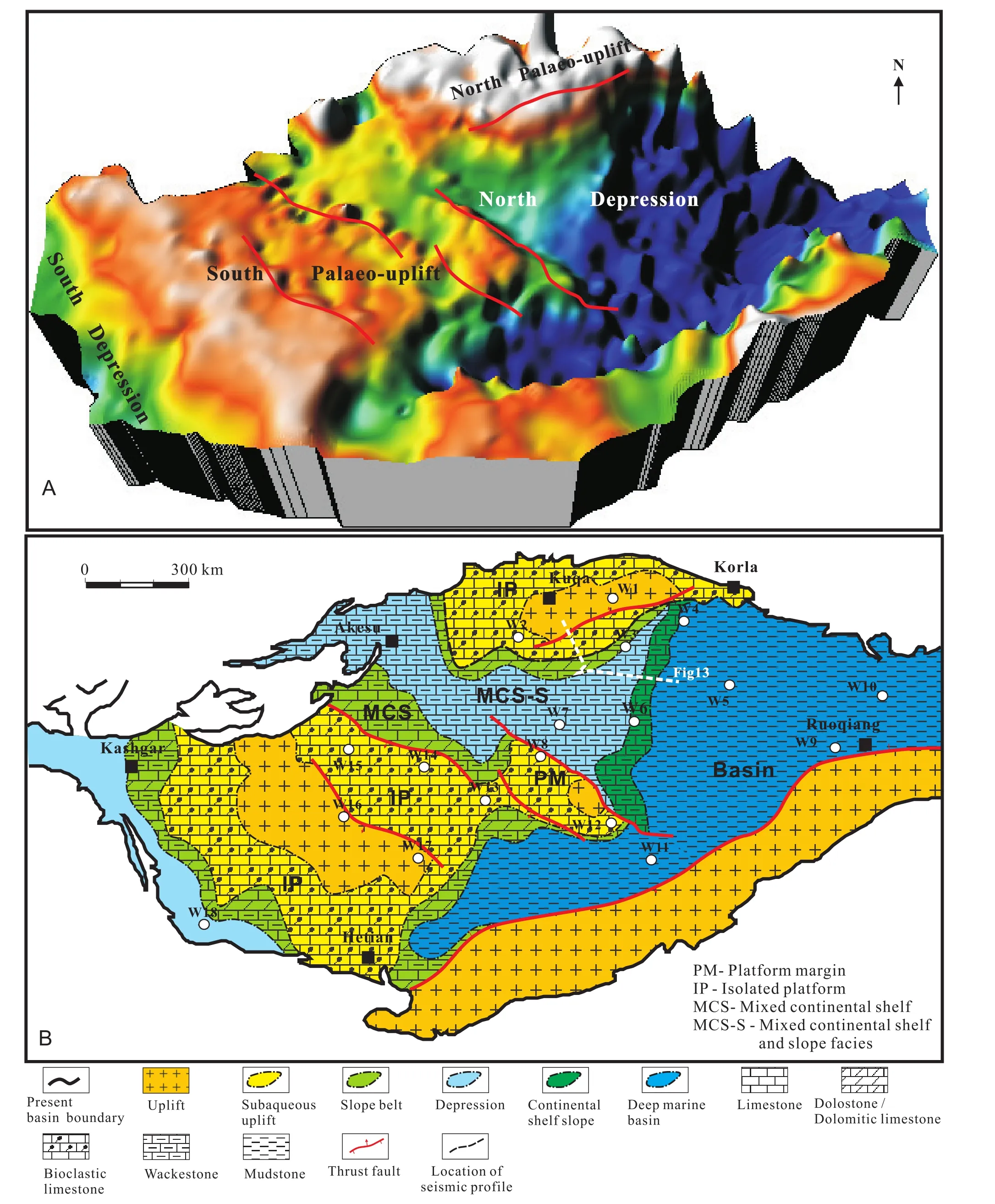
Figure 12 Tectonic palaeogeomorphology and sedimentary facies of the Mid-Late Ordovician in the Tarim Basin. Note that the geomorphologic units developed during this period include eroded uplift areas, subaqueous lower uplift, slope, local depression, continental shelf and deep basin. Uplift areas provided source materials, mixed shelf deposition developed in local depression areas, and isolated platform facies developed in subaqueous lower uplift areas. The platform margin facies developed adjacent to the Tahzong No. 1 Fault Belt of the Tazhong Uplift. A is a 3-D map of palaeostructure (Figure 12B is modified from Liu et al., 2015 online).
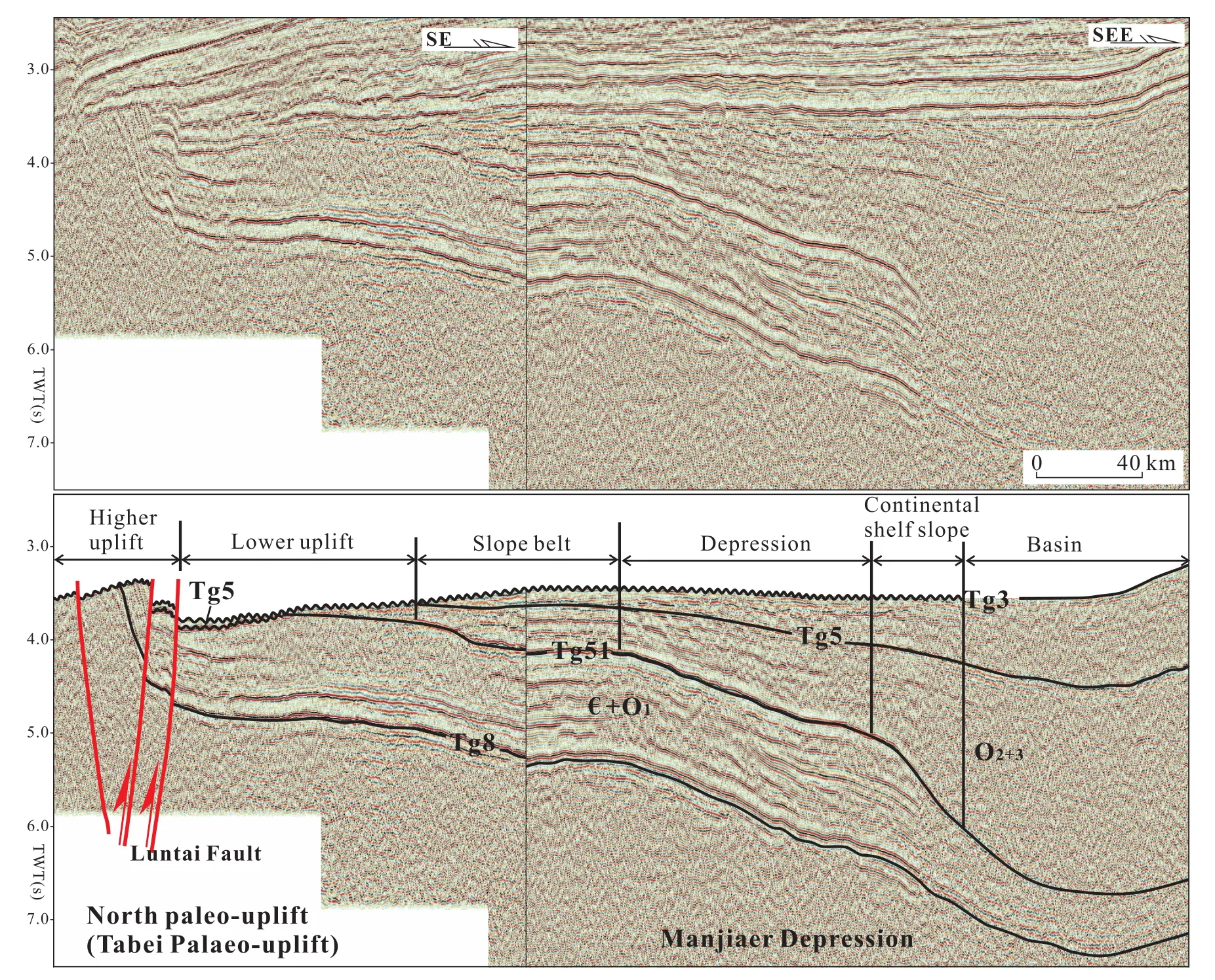
Figure 13 Developing characteristics of the Mid-Late Ordovician slope break belts in areas from the Tabei Palaeo-uplift to the Manjiaer Depression. Note that multi-order associations of palaeogeographic units from higher uplift area of the Tabei Palaeo-uplift to the basin showing an apparent control on depositional systems, seeing Figure 9 for the locations of seismic profiles.
6 Discussion: Relationship between slope break belt system and stratal-lithologic trap
6.1 Distribution of slope break belt systemunconformity and stratal trap
6.1.1 Higher uplift area and superimposed unconformity
Usually a dominant unconformity, with a large erosion area, large amount of eroded stratal thickness and a long erosion history which represents the most dominant uplift and erosion period, exists within an unconformity superimposed belt and occurs as a higher uplift area in palaeogeomorphologic units(Lin et al., 2012a; Liu et al., 2015 online). The late Late Ordovician and late Middle Devonian unconformities (Tg5 and Tg3 respectively) are dominant tectonic epoch unconformites which formed superimposed belts along with the underlying unconformities.Distribution of superimposed unconformity is generally controlled by large-scale fault slope break belt within the basin. The simultaneously intense extrusion on these thrust faults lead to a sharp elevation and a long period of erosion of the hanging wall. Resultantly, locations where these fault belts develop are usually boundary belts between higher and lower uplift areas within a palaeo-uplift and boundary between superimposed and individual period unconformities as well. For example, the palaeogeomorphologic map of the Silurian-Early-Middle Devonian(Fig. 14) indicates that strong tectonic movement of the late Late Ordovician led to the formation of the Tabei and Tanan Palaeo-uplifts. Within the Hetian, Tazhong and Tabei higher uplift areas of the Tanan Palaeo-uplift, the Mazhatake, Tazhong No. 1 and Luntai Faults developed respectively which separate higher and lower uplifts (or slope belt) areas. At dominant locations where faults develop on seismic profile, apparently multi-period superimposed unconformity evolves into individual period unconformity (Fig. 16).
6.1.2 Lower uplift area and truncation-onlap association unconformity
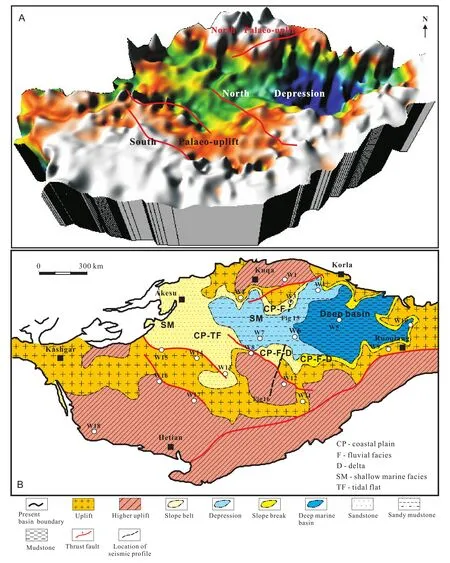
Figure 14 Tectonic palaeogeomorphology and sedimentary facies of the Silurian to Early-Middle Devonian in the Tarim Basin. Note that uplift areas expanded further and depositional areas reduced. Onshore-fluvial-deltaic sandstone, tidal flat muddy sandstone, shallow marine sandy mudstone, basin facies mudstone and basin floor fan developed in eroded areas in the basin. A is a 3-D palaeostructural map(Figure 14B is modified from Liu et al., 2015 online).
Unconformity developed in lower uplift area is dominantly truncation type with truncation-onlap association(Fig. 16). From higher uplift area to lower uplift area,usually secondary unconformity or important sequence boundary first develops beneath the dominant unconformity which forms a truncation unconformity triangle belt(Lin et al., 2008); Whereas the secondary unconformity above the dominant unconformity onlaps above this boundary layer by layer, and is named as onlap unconformity triangle belt (Lin et al., 2012a; Liu et al., 2015 online) (Fig. 16).
6.1.3 Slope belt (slope break belt) and overlap unconformity
Slope belt is mainly located in the lower part of an uplift area and is dominated by regional onlap reflection on dominant and secondary unconformities (Liu et al., 2015 online).Palaeo-uplifts within the Tazhong Palaeo-uplift formed by the Late Ordovician tectonic movement experienced an obvious uplifting during the Silurian period. From the Manjiaer Depression towards the south, an apparent wedge-shape overlap body (Fig. 17) developed on the Tazhong southern slope. In addition, typical stratal onlap developed adjacent to two large-scale continental shelf slope break belts which were formed in the Cambrian-Ordovician. And onlap of this period usually developed during the period when relative sea-level falled beneath continental shelf slope break belt(Fig. 16).
Truncation and onlap unconformities within a palaeouplift and along a palaeo-slope belt are profitable for the formation of important unconformity traps. Coarsegrained deposits of lowstand systems tract developed along marginal areas of the remnant basin during tectonic uplift period. Clastic coastal deposits of early transgression period developed along marginal belt of palaeo-slope associated with tectonic subsidence and transgression.This kind of clastic depositional system onlapping over unconformity generally constitutes important reservoir within a basin. Onlap unconformity triangle belt above the unconformities of the late Late Ordovician (Tg5) and late Middle Devonian (Tg3) of the Tarim Basin forms significant lithostratigraphic traps. Seismic profile characteristics indicated that from palaeo-uplift margin towards slope belt along the margin of a depression, overlap of the transgressive systems tract of the Early Silurian and Late Devonian-Early Carboniferous formed a wide onlap unconformity belt (Fig. 17). A palaeo-uplift was drowned mostly or entirely along with transgression expansion.The overlying marine mudstone or muddy limestone constitutes favourable reservoir-cap rock association. The large-scale Hadexun oil and gas field located at southern slope belt of the Tabei Palaeo-uplift in the northern Tarim Basin is a hydrocarbon accumulation type related with this kind of sandbody and trap. Truncation unconformity triangle belt formed by the late Middle Devonian unconformity (Tg3) can be found widely on seismic profiles and important hydrocarbon accumulations have already been discovered in stratigraphic traps which were formed by the Silurian sandstone below the unconformity and cap rocks above the unconformity (Li et al., 2002; Lin et al.,2008).
6.2 Slope break system-reef, beach high energy facies belt along slope margin of a palaeouplift and structural-lithologic composite trap
Development and distribution of carbonate rock sedimentary facies is related with depositional kinetic energy,water depth, photic zone and other factors which are directly controlled by palaeogeomorphologic characteristics at depositional period. Sedimentary facies of carbonate rocks changes orderly from uplift area towards slope and basin area. Slope (slope break) belt along margin of a palaeo-uplift, indicating a sharp change from shallow water platform to deep water environment, is a palaeogeomorphologic unit (Fig. 13) within which high energy sedimentary facies, such as reef, oolitic sandy clastic or bioclastic limestone beach bar facies develops. The Upper Ordovician, dominated by reef, beach bar deposits, mostly developed in highstand systems tract beneath the main unconformity (Lin et al., 2008). Syngenetic dissolution occurs frequently on unconformity or exposed sequence boundary. Petroleum exploration indicated that the platform margin slope of Tazhong No. 1 Fault on northern side of the Tazhong Palaeo-uplift is a profitable hydrocarbon accumulation belt where high energy sedimentary facies,along with karst and fissure belt, formed penetrative and connective body which was favourable for the formation of petroleum reservoirs and constituted dominant reservoir of litho-stratigraphic hydrocarbon accumulations found in this area.
6.3 Slope break system-palaeo-uplift and its relevant slope break belt forming favourable areas for hydrocarbon accumulation
Slope break system in the Tarim Basin is generally closely related with palaeo-uplift and fault developed at different periods. Development of the northern and southern slope break belts of the Silurian are mainly controlled by the large-scale Tabei and Tazhong Palaeo-uplifts of the Tarim Basin. Most petroleum reservoirs concentrate in this type of palaeo-uplifts. The gigantic Tabei Palaeo-uplift belongs to a typical remnant palaeo-uplift which existed until the Early Neogene and was deeply buried and transformed into a foredeep belt of the Tabei Foreland basin (Liu et al., 2012b). Due to many times of uplifting and erosion,the top part of the uplift is incomplete with poor reservation conditions for hydrocarbon accumulations and thus is difficult to form large-scale oil and gas fields; whereas the Mesozoic and Cenozoic structural intervals of its upper part can form secondary hydrocarbon accumulations.Strata developed completely on slope area of flanks with good preservation conditions and development of erosion line and onlap pinch-out line which made it a main hydrocarbon accumulation area and the most favourable area for the formation of large-scale original hydrocarbon accumulations. For example, the Tahe Oilfield was formed on slope area of the Lunnan Palaeo-uplift (Yang et al., 2007;Zhang et al., 2011; Zhou et al., 2009). The Tazhong Palaeouplift, since its formation in the Late Ordovician, should own the best preservation conditions due to stable tectonics, whereas oil and gas discovered there are far less than in the Tabei Palaeo-uplift. Whether or not that oil and gas mainly concentrate in stratal-lithologic traps or in deep buried strata or along slope belt? Petroleum-rich character of this type of palaeo-uplift (Lv et al., 2008; Sun et al.,2007; Wang et al., 2009; Yang et al., 2007) is testified by considerable breakthrough of oil and gas exploration from the Lower Paleozoic along the northern slope break belt of Tazhong area.

Figure16 Relationshipamong tectonic palaeogeomorphology, unconformities andsequencedeposition. Thelocationof seismicprofile is showninFigure14. Twoimportant depositional systems tracts canbeidentified in thestudy area when taking palaeo-uplift evolutionand sea-level rise andfall into consideration. Thefirst oneis adetrital depositional system of alowstand systems tract developing along theremnant basinmargins during themaximum tectonic uplift period with erosionof higher uplift areas andslope belt. Thesecondis acoastal clastic depositional system of atransgressive systems tract developing along palaeo-slope belts after tectonic uplift.

Figure17 A-Seismic onlapcharacteristics adjacent to slopebelt aboveTg5. At least threeonlap bodies, whichdeveloped during theSilurian, onlapped, from theManjiaer Depression towards thesouth, along thenorthernslope belt of theTazhong Palaeo-uplift. Planar distribution of onlapsurfaces 1and 2tendtocoincidewithtrend of theTazhong Palaeo-uplift. These three onlapsurfaces were truncatedbyTg3 along thesouthernslope of theTabei Palaeo-uplift anddistributionof erosionlines coincidedwithtrend of thesouthernslope of theTabei Palaeo-uplift (B).
7 Conclusions
1) Based on analysis of seismic and log data, the study results indicate that four major widespread angular to micro angular unconformities (Tg8, Tg51, Tg5 and Tg3) formed during the Paleozoic. Three tectonic sequence boundaries coincide with the main tectonic change periods of the Paleozoic in the Tarim Basin.
2) Palaeogeomorphologic framework of the Cambrian-Early Ordovician is approximately EW trending overall within which the Tabei Palaeo-uplift, northern Depression Belt and southern Palaeo-uplift develop respectively.Slope break belt includes, fault, flexure (slope), continental shelf, and palaeogeomorphologic units related to slope break belt include palaeo-uplift, depression and deep basin area which can be grouped into the Tabei and southern Palaeo-uplift slope break systems respectively, and exerted a significant control on deposition of isolated platform, open platform, restricted platform and deep basin.
3) The extrusion of the Mid-Late Ordovician led to uplift and erosion of the southern and northern subaqueous uplifts and resultantly two slope break systems, namely as the northern and Central Uplifts, developed. Regardless of slope break system, palaeogeomorphologic association constituted by multi-order slope break belt or geomorphologic units was formed and distributed from palaeo-uplift erosion area towards depression area which obviously controls deposition of provenance area, isolated platform, mixed continental shelf, slope and basin facies.
4) Great tectonic deformation occurred in the Tarim Basin after the intensive extrusion of the Mid-Late Ordovician which is characterized by large-area of uplift and erosion,and development of anticline and syncline in EW direction.The Tabei, southern and Tadong Palaeo-uplifts controlled deposition of shore, tidal, delta, shallow marine clastic and deep marine faices in the basin.
5) Area adjacent to slope break belt of a slope break system is usually closely related with all kinds of stratigraphic unconformity. Truncation and onlap unconformity zones within a palaeo-uplift and a palaeo-slope belt are favourable areas for forming important unconformity traps.Slope (slope break) belt of a palaeo-uplift margin is a high energy sedimentary facies, and those units such as reef,oolitic sandy clastic or bioclastic limestone beach bar are favorable for forming litho-structural composite hydrocarbon accumulations when tectonic conditions are suitable as well. Large-scale palaeo-uplift provides the most favourable condition for hydrocarbon accumulation as well.
 Journal of Palaeogeography2015年3期
Journal of Palaeogeography2015年3期
- Journal of Palaeogeography的其它文章
- Sequence architecture of a Jurassic ramp succession from Gebel Maghara (North Sinai, Egypt): Implications for eustasy
- Lithofacies architecture and palaeogeography of the Late Paleozoic glaciomarine Talchir Formation, Raniganj Basin, India
- Palaeogeography of a shallow carbonate platform: The case of the Middle to Late Oxfordian in the Swiss Jura Mountains
- 3D palaeogeographic reconstructions of the Phanerozoic versus sea-level and Sr-ratio variations: Discussion
- Reply to comments by G. Shanmugam(2015) and A. J. (Tom) van Loon (2015)on “3D palaeogeographic reconstructions of the Phanerozoic versus sea-level and Sr-ratio variations”
- 2nd International Palaeogeography Conference October 10–13, 2015, Beijing, China
